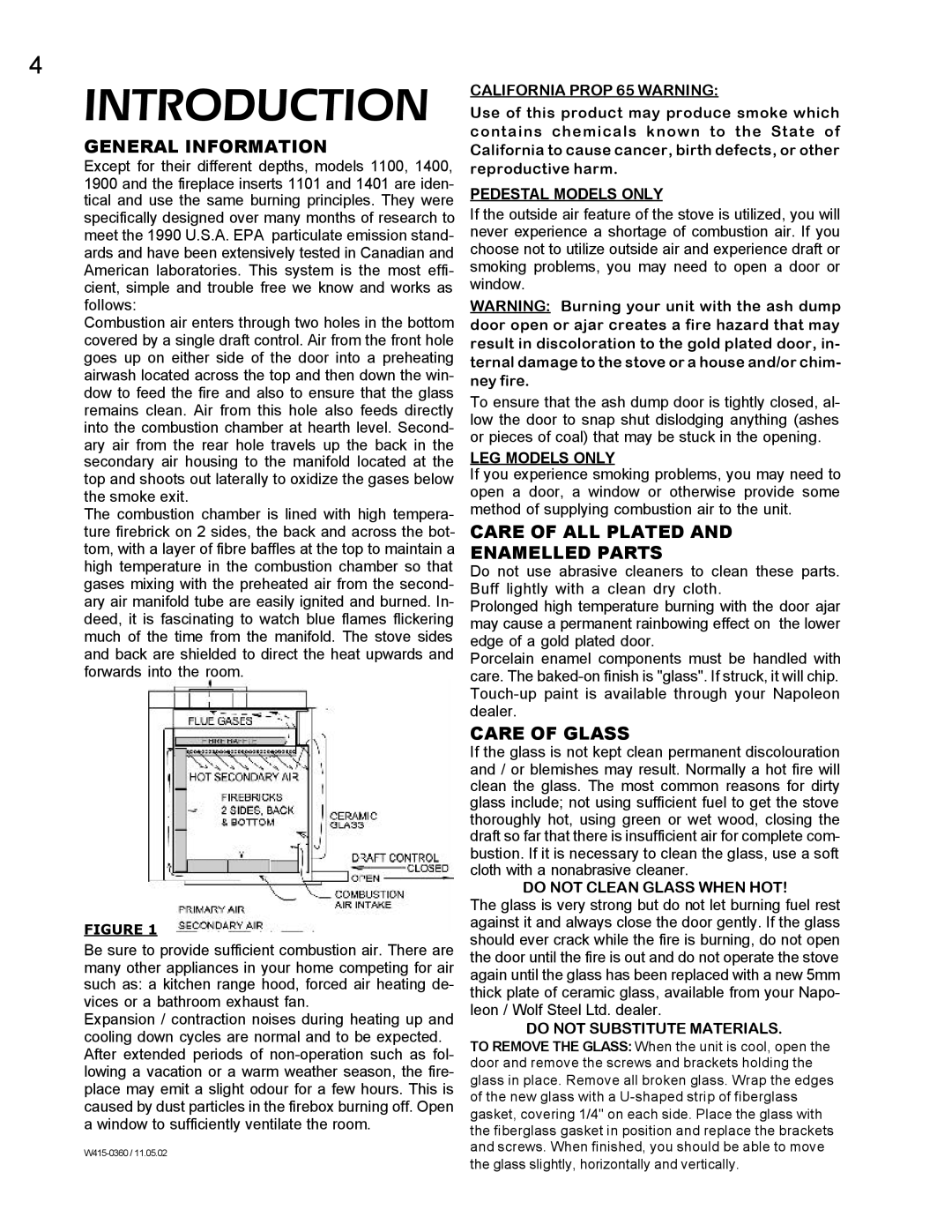
4
INTRODUCTION
GENERAL INFORMATION
Except for their different depths, models 1100, 1400, 1900 and the fireplace inserts 1101 and 1401 are iden- tical and use the same burning principles. They were specifically designed over many months of research to meet the 1990 U.S.A. EPA particulate emission stand- ards and have been extensively tested in Canadian and American laboratories. This system is the most effi- cient, simple and trouble free we know and works as follows:
Combustion air enters through two holes in the bottom covered by a single draft control. Air from the front hole goes up on either side of the door into a preheating airwash located across the top and then down the win- dow to feed the fire and also to ensure that the glass remains clean. Air from this hole also feeds directly into the combustion chamber at hearth level. Second- ary air from the rear hole travels up the back in the secondary air housing to the manifold located at the top and shoots out laterally to oxidize the gases below the smoke exit.
The combustion chamber is lined with high tempera- ture firebrick on 2 sides, the back and across the bot- tom, with a layer of fibre baffles at the top to maintain a high temperature in the combustion chamber so that gases mixing with the preheated air from the second- ary air manifold tube are easily ignited and burned. In- deed, it is fascinating to watch blue flames flickering much of the time from the manifold. The stove sides and back are shielded to direct the heat upwards and forwards into the room.
FIGURE 1
Be sure to provide sufficient combustion air. There are many other appliances in your home competing for air such as: a kitchen range hood, forced air heating de- vices or a bathroom exhaust fan.
Expansion / contraction noises during heating up and cooling down cycles are normal and to be expected. After extended periods of
CALIFORNIA PROP 65 WARNING:
Use of this product may produce smoke which contains chemicals known to the State of California to cause cancer, birth defects, or other reproductive harm.
PEDESTAL MODELS ONLY
If the outside air feature of the stove is utilized, you will never experience a shortage of combustion air. If you choose not to utilize outside air and experience draft or smoking problems, you may need to open a door or window.
WARNING: Burning your unit with the ash dump door open or ajar creates a fire hazard that may result in discoloration to the gold plated door, in- ternal damage to the stove or a house and/or chim- ney fire.
To ensure that the ash dump door is tightly closed, al- low the door to snap shut dislodging anything (ashes or pieces of coal) that may be stuck in the opening.
LEG MODELS ONLY
If you experience smoking problems, you may need to open a door, a window or otherwise provide some method of supplying combustion air to the unit.
CARE OF ALL PLATED AND
ENAMELLED PARTS
Do not use abrasive cleaners to clean these parts. Buff lightly with a clean dry cloth.
Prolonged high temperature burning with the door ajar may cause a permanent rainbowing effect on the lower edge of a gold plated door.
Porcelain enamel components must be handled with care. The
CARE OF GLASS
If the glass is not kept clean permanent discolouration and / or blemishes may result. Normally a hot fire will clean the glass. The most common reasons for dirty glass include; not using sufficient fuel to get the stove thoroughly hot, using green or wet wood, closing the draft so far that there is insufficient air for complete com- bustion. If it is necessary to clean the glass, use a soft cloth with a nonabrasive cleaner.
DO NOT CLEAN GLASS WHEN HOT!
The glass is very strong but do not let burning fuel rest against it and always close the door gently. If the glass should ever crack while the fire is burning, do not open the door until the fire is out and do not operate the stove again until the glass has been replaced with a new 5mm thick plate of ceramic glass, available from your Napo- leon / Wolf Steel Ltd. dealer.
DO NOT SUBSTITUTE MATERIALS.
TO REMOVE THE GLASS: When the unit is cool, open the door and remove the screws and brackets holding the glass in place. Remove all broken glass. Wrap the edges of the new glass with a
